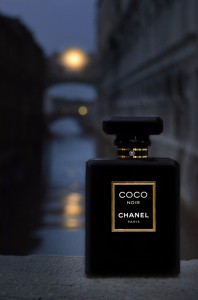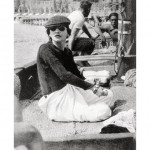Guerlain – Samsara
If you are a perfume afficionada, one of the benefits of going to an all-women’s college is the rather obvious proximity of many young women wearing many different fragrances. In my hallway alone, I was greeted each morning by a variety of freshly-showered Chanels and Calvin Kleins as they made their way to morning classes. Into the melange of perfumed heads making their way down Broadway in 1989, came a stunning new creature. She had a cascading mane of beautiful curls atop her slender figure, wore a tiny nose-ring balanced with a huge scarf (which seemed to perfectly match her studies in comparative religion and art), smoked Camels like there was no tomorrow, and was French Canadian to boot. She cut quite an impressive figure in the sea of Eternity, because, of course, she wore Samsara.
Named for the continuous cycle of birth, death and rebirth, she railed against the ironic name choice for what was such a simply beautiful fragrance (though given the state of Guerlain’s current output, I find myself desperately wishing for rebirth at this point). As a child of the 1980s, Samsara wove an exotic tale, this time of India, with its references to sandalwood and its stylized, deep red bottle. Indeed, vintage Samsara is legendary for containing some of the highest quality sandalwood, in unprecedented amounts.
Into this rich, delicately sweet wood, Jean-Paul Guerlain had the brilliance of introducing a rich jasmine note. While Samsara is certainly recognizable from a distance, unlike many other fragrances of the 1980s, it was never cloying, as the equally demanding notes of sandalwood and jasmine worked in perfect harmony, rather than competing for top billing. The rich rose and ylang notes imparted a nearly palpable creaminess to the fragrance, lending it soft edges and voluptuousness. Perhaps I have been tainted by the intense sillage of other fragrances in my collection, but I find that Samsara wears fairly close to the skin.
The drydown hints at Guerlain heritage, with vanilla and tonka making their symbolic appearance, warming the jasmine petals and woods into a warm skin scent. The EdT places emphasis on the jasmine, while the EdP and Parfum highlights the beauty of sandalwood. While Samsara makes perfect sense (and even appears subtle) in today’s fragrance environment, at the time it was released it was instantly recognizable and larger than life. An intriguing and sophisticated choice for a woman barely in her twenties. Whenever I reach for it, I am reminded of of her unique, indomitable spirit.
Notes: Bergamot, Jasmine, Narcissus, Rose, Ylang Ylang, Sandalwood, Iris, Tonka, Vanilla.
*A further note on the fragrance – as I commenced writing this review, I instantly realized why Jasmin et Cigarette had failed to hit the spot for me. The perfect combination of jasmine, tobacco and smoke had already been achieved (albeit unintentionally) by my Samsara wearing friend.





